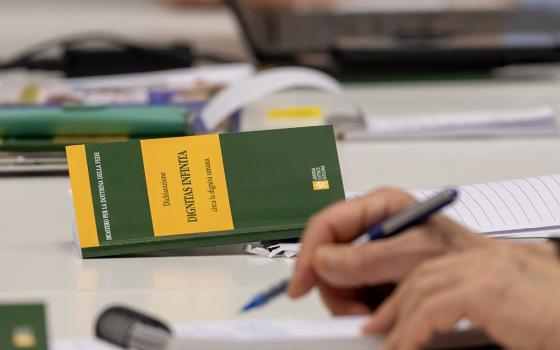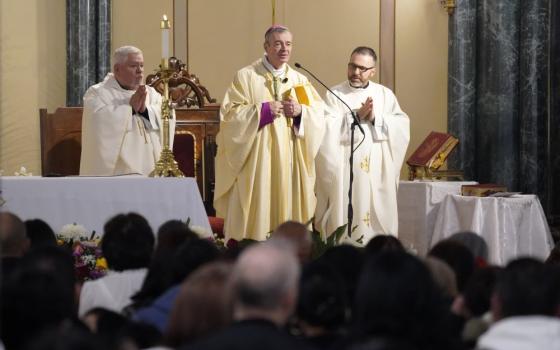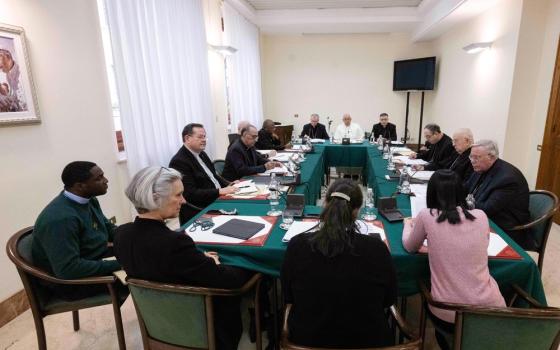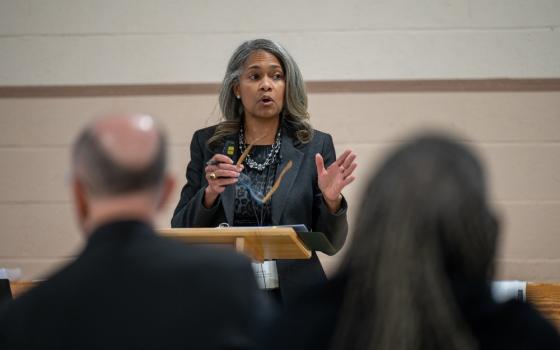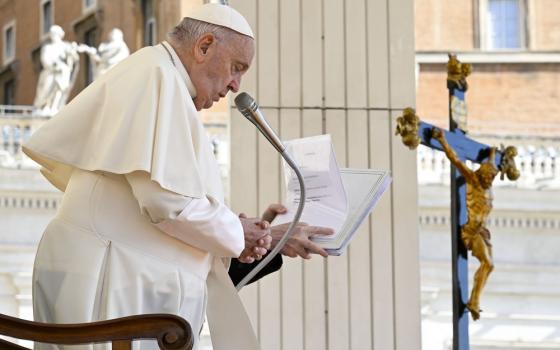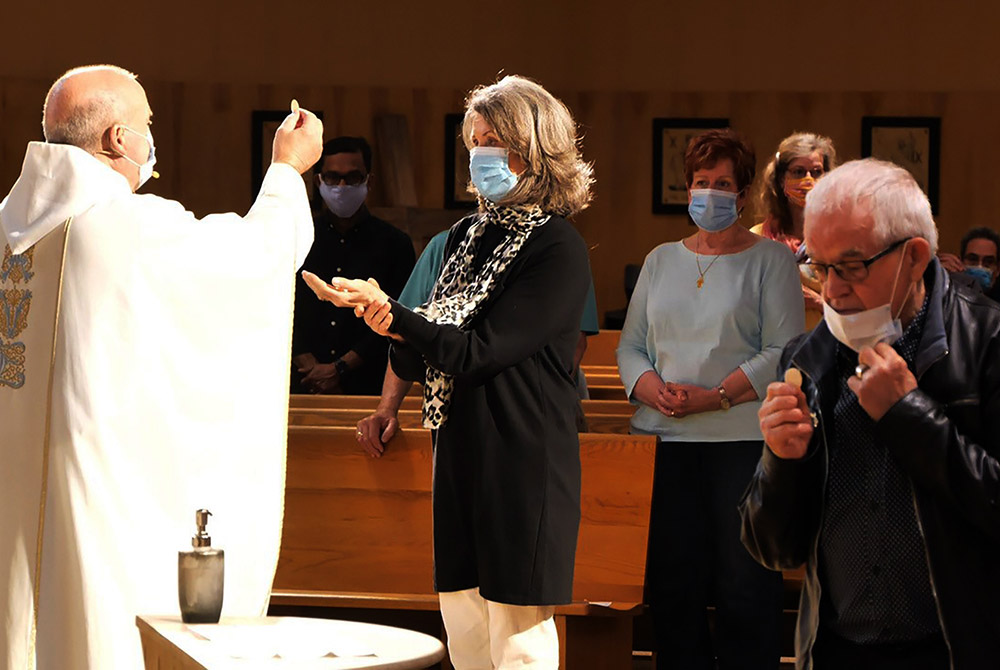
Parishioners at Our Lady of Perpetual Help in Sherwood Park, Alberta, receive Communion from their pastor, Fr. Jim Corrigan, June 1. It was the first public Mass since churches were closed amid the COVID-19 pandemic. (CNS/Matthew Bodnarek, Grandin Media)
Since March of this year, the coronavirus pandemic has necessitated church closures across the U.S. and across faith communities. Catholic worshipers have gathered on electronic platforms to participate in Mass; some groups have gathered in parking lots within the safety of their vehicles.
If anyone would have predicted this state of affairs last year, they would have met with disbelief and ridicule. But as June blossoms into summer, some places of worship are slowly and cautiously (we hope) opening up once again. We are collectively breathing a sigh of relief.
We might do well to ask ourselves what the pandemic has taught us. What have we learned about our faith, the centrality of the Eucharist, and the importance of being a part of the local body of Christ that we call parish?
Informally, Catholics have shared a variety of insights about the experience of celebrating Eucharist online. Some have created prayer spaces in their living room with crucifix, candles and fresh flowers. Others have included a display of simple bread and wine on their coffee tables.
Has our experience of quarantine somehow made us more conscious or more intentional about celebrating the symbols in the ritual we call Mass? Has the online sight of the altar and the sacred space (temporarily out of reach) deepened our desire to participate in the liturgy and to participate perhaps more intentionally than we might have done in the past?
On the other hand, have we perhaps wondered why we cannot continue to attend online and be done with parking lot skirmishes and other traveling challenges?
When commenting on what they miss most, Catholics mention the sacramental reception of holy Communion and being a part of or present with a community of faith. What does that tell us about who we are or who we understand ourselves to be? Unpacking the word, "communion," may be a good place to start.
While many people of faith focus on being united with Christ in the reception of holy Communion, there is another important aspect to the deep and profound meaning of communion. As we are united with Christ, so are we also united with each other. Our life’s task is to become ever more the one body of Christ that our baptism and each reception of holy Communion calls us to become.
This might also be a good time to recall that Article 7 of the Second Vatican Council’s Constitution on the Sacred Liturgy (Sacrosanctum Concilium, 1963) asserts that Christ is present in our liturgical celebrations in multiple modes. Christ is present in the church gathered for worship, the presider who leads the assembly in prayer, the sacred word of Scripture that is proclaimed and in the consecrated bread and wine.
All of these modes of Christ’s presence interact with each other in the liturgy and are part of the larger and deeper reality of Christ’s presence in the church. Our prayer can be thrown off balance if we focus on one of these modes to the detriment of the others.
Not attending Mass involves giving up a lot more than sacramental Communion. It involves not being present for the proclamation of the Scriptures. It also involves not being a part of the gathered assembly who are, in that time and place, the presence of Christ.
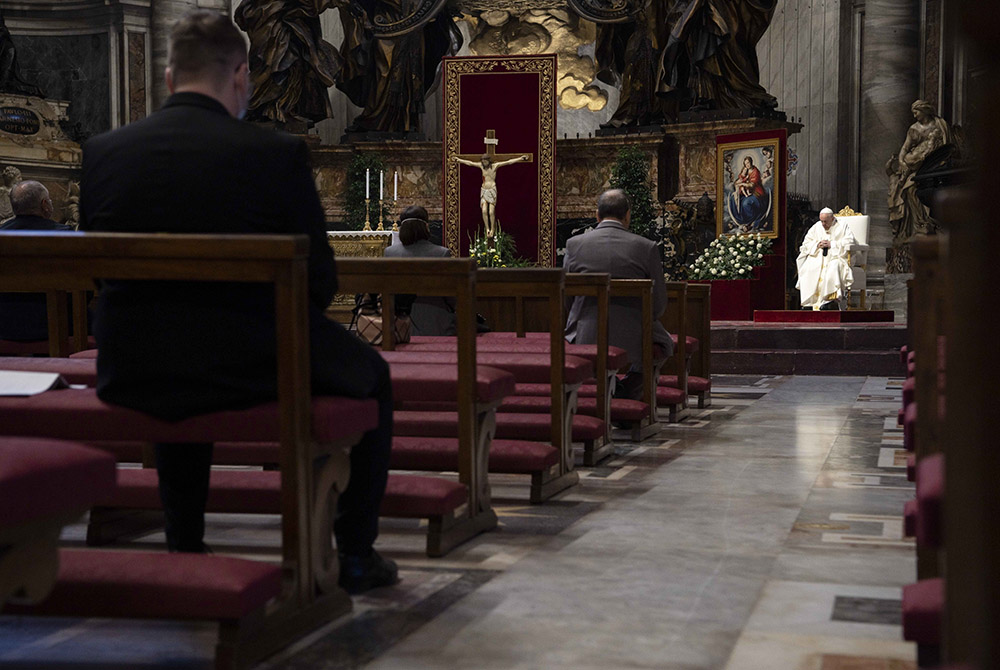
People wear masks as Pope Francis celebrates Mass marking the feast of Corpus Christi in St. Peter's Basilica at the Vatican June 14. The Mass was celebrated with a small congregation of some 50 people as part of efforts to contain spread of the coronavirus. (CNS/Tiziana Fabi, Reuters pool)
We need to receive that witness from each other; we need to witness to others as well. And this witness needs to be carried out of the church building. In this "in-between" time of not attending Mass in person, we have the opportunity to recall and to live out the fact that God’s loving presence is always with us and that we are called to share it with everyone we meet.
Because the eucharistic liturgy is so rich in unfolding Christ’s presence, the church does not encourage Communion services, except when there is no one available to preside at the Eucharist, particularly for Sunday celebrations. At a Communion service, consecrated hosts from the tabernacle that were consecrated at a previous Mass are distributed to the faithful.
Perhaps one reason why the assembly sees little difference between a Communion service and the Mass is that, against the guidelines in the General Instruction of the Roman Missal (Article 85), many churches regularly distribute Communion at Sunday Mass from the tabernacle instead of from the altar. How we handle liturgical symbols really does matter.
So, what about the idea of simply continuing to celebrate Mass online? Would that make the church more up-to-date and technologically savvy? Ah, well there is that "little" doctrine of the Incarnation. It is fundamental to our understanding of ourselves in relation to God and also our understanding of sacramentality.
Because the Second Person of the Trinity took on human flesh and was born of the Virgin Mary, our relationship to bodiliness and God’s relationship to bodiliness are forever and fundamentally changed. God chooses to communicate with humankind through material or bodily reality since God first chose to take on human flesh.
All of the sacraments have a physicality or sense of embodiment about them that allows us, as human creatures, to celebrate God’s action and love in our lives through material reality. That is what we mean by "sacramental."
Christians are baptized into the church with water and oil. We strengthen and deepen our relationship with God through eating bread and drinking wine that have become the body and blood of Christ. Touch is involved in all of the sacraments. Christians are not afraid of touch because God first touched us.
Advertisement
That physicality, when mediated by the internet or other types of platforms is not the direct experience that "being there" can afford. People in the armed services communicate via the web with loved ones. But nothing can compare to the hugs and kisses that are the "real thing." Ask anyone who graduated online this spring. When love is involved, personal presence is essential.
We are anticipating a return to the "real thing." Will that return find us more attentive, more intentional, more grateful, more generous in the way we celebrate the Eucharist? There is no audience in the liturgy. We are all called to be active participants and members one of another in the one body of Christ.
In the meantime, I would like to offer an alternative prayer of spiritual communion:
"Lord Jesus Christ, you promised to be with your church always, until the end of time.
We long to experience your presence more deeply and more intimately
even when we cannot gather in person as church to celebrate Eucharist.
We believe that you are present when we gather to worship.
We believe you are present in your ordained minister and in your sacred word when the
Scriptures are proclaimed.
And we believe you are present when your sacred body and blood become our food and drink.
Our relationship with you is truly grace.
When I am not able to be physically present at the Eucharist with the community,
help me to strengthen and deepen my relationship with you
as I seek to encounter and serve you,
not only in prayer
but all I meet, especially in the poor and needy of our world.
Amen."
[Felician Franciscan Sr. Judith M. Kubicki is an associate professor emerita of theology at Fordham University and a past president of the North American Academy of Liturgy.]


